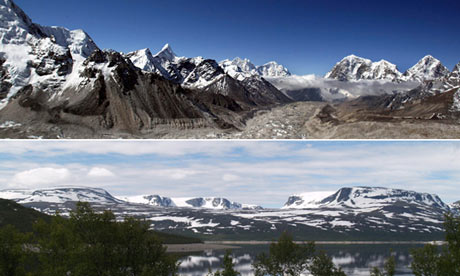Soot clouds pose threat to Himalayan glaciers
Fumes from wood fires and from diesel engines accelerate melting, Indian scientists warn
- Randeep Ramesh and Suzanne Goldenberg, The Observer, 4 October 2009

Top: Aerial photograph of the Khumbu Glacier and the Everest Himalayan range. Bottom: Glacially eroded mountains in Jotunheimen in Norway. Photograph: David Lundbek Egholm (bottom) and Paula Bronstein/Getty Images
The results, to be announced this month in Kashmir, show for the first time that clouds of soot – made up of tiny particles of "black carbon" emitted from old diesel engines and from cooking with wood, crop waste or cow dung – are "unequivocally having an impact on glacial melting" in the Himalayas.
Scientists say that, while the threat of carbon dioxide to global warming has been accepted, soot from developing countries is a largely unappreciated cause of rising temperatures. Once the black carbon lands on glaciers, it absorbs sunlight that would otherwise be reflected by the snow, leading to melting. "This is a huge problem which we are ignoring," said Professor Syed Hasnain of the Energy and Resources Institute (Teri) in Delhi. "We are finding concentrations of black carbon in the Himalayas in what are supposed to be pristine, untouched environments."
The institute has set up two sensors in the Himalayas, one on the Kholai glacier that sits on the mountain range's western flank in Kashmir and the other flowing through the eastern reaches in Sikkim. Glaciers in this region feed most of the major rivers in Asia. The short-term result of substantial melting is severe flooding downstream.
Hasnain says India and China produce about a third of the world's black carbon, and both countries have been slow to act. "India is the worst. At least in China the state has moved to measure the problem. In Delhi no government agency has put any sensors on the ground. [Teri] is doing it by ourselves."
In August this year Yao Tandong, director of China's Institute of Tibetan Plateau Research, projected "a 43% decrease in glacial area by 2070", adding that "more and more scientists have come to recognise the impact of black carbon in glacial melting."
Black carbon's role has only recently been recognised – it was not mentioned as a factor in the UN's major 2007 report on climate change –but this month the UN environment programme called for cuts in black carbon output. In November it will publish a report stating that 50% of the emissions causing global warming are from non-CO2 pollutants.
Decreasing black carbon emissions should be a relatively cheap way to significantly curb global warming. Black carbon falls from the atmosphere after just a couple of weeks, and replacing primitive cooking stoves with modern versions that emit far less soot could quickly end the problem. Controlling traffic in the Himalayan region should help ease the harm done by emissions from diesel engines.
Both New Delhi and Beijing, say experts, have been reluctant to come forward with plans on black carbon because they do not want attention diverted from richer nations' responsibility to cut carbon dioxide emissions.
At a high-level forum on energy in Washington on Thursday, India's environment minister, Jairam Ramesh, rejected attempts to link black carbon to the efforts to reach an international agreement to cut greenhouse gas emissions. Black carbon had no place in the Copenhagen negotiations towards a global pact on global warming, he said. "Black carbon is another issue. I know there is now a desire to bring the black carbon issue into the mainstream. I am simply not in favour of it."
Link: http://www.guardian.co.uk/environment/2009/oct/04/climate-change-melting-himalayan-glaciers







No comments:
Post a Comment